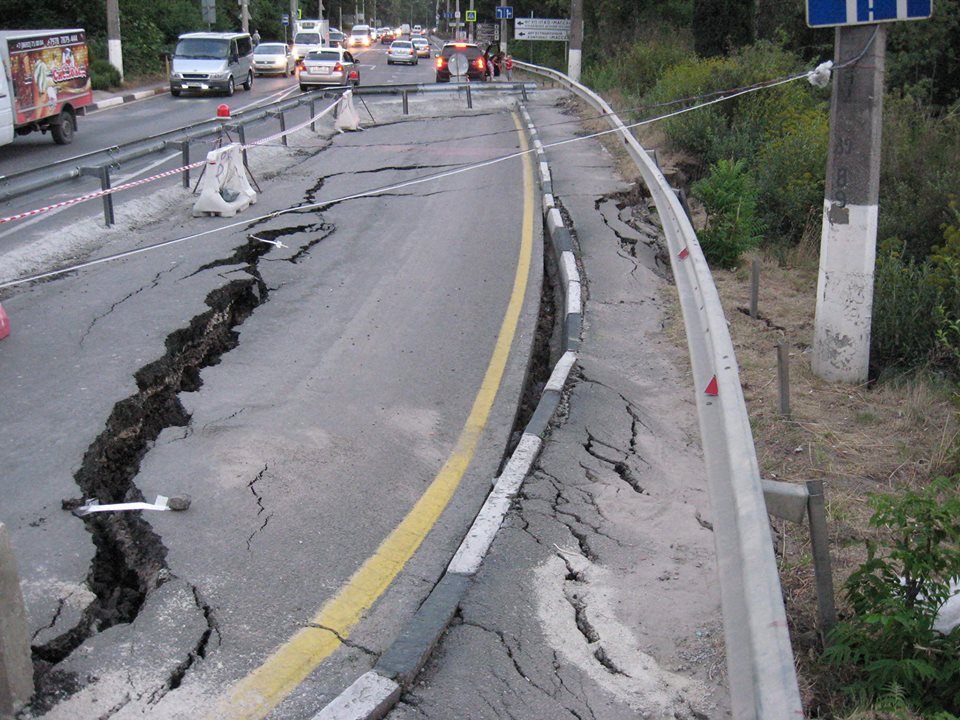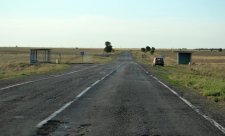Having annexed Crimea, Russia promised many things, including new roads for the peninsula. However, it is about three and а half years since the occupation, but not a single kilometer of new road has been built. Capital repairs are also only on the paper, and Russian companies actively pack the Russian billions into the asphalt with the help of current repair works.
Funding for Crimean roads
It is virtually impossible to find out how much money Russia is ready to allocate for Crimea, because the appetite of local ‘authorities’ are constantly growing. For example, the Program for the road sector of Crimea for 2015-2017 provided for the allocation of 200 billion rubles: 90 billion for the Taurida road and the remaining funds – for major repairs of 1316 km of Crimean roads (about one quarter of all roads of the peninsula).
However, major repair works covered just a few kilometers (in the line of engineering protection) at the end of the second year of the program implementation. Apparently, repair works of other 1314 km were postponed for 2017.
More recently, the ‘head’ of Crimea Sergey Aksenov said that Russia allocated a combined total of 18 billion rubles ($284 million) to repair the peninsula’s roads in 2016, and 11.5 billion ($182 million)of this sum – for inter-municipal roads (total length of 6267 km) and 2.1 billion rubles – for municipal roads (total length of 8650 km). Crimea got another 4.5 billion rubles ($71 million) after the visit of the Russian Prime Minister Dmitry Medvedev shortly before the elections in the State Duma.
However, to what extent the Crimean ‘Prime Minister’ can be trusted if the data he voiced too often differ from reality. For example, in 2015 Aksenov said that 218 km of automobile roads have been repaired in Crimea, although the Roads Service reported only about the repair of 50 km (mostly, on the Simferopol-Feodosia route).
It also seems curious that as we believe the ‘head’ of Crimea, more than 200 km of roads have been repaired with 7 billion rubles allocated in 2015, but, according to the Crimean ‘Minister’ of Transport Anatoliy Volkov, in case the funding is increased by several billions in 2016, it will allow to repair only 155 km. The Roads Service is planning to repair even less – only 60 km.
Landslide on the Alushta-Yalta road. Photo from social networks
In 2016, in addition to the Kerch road, the Simferopol-Nikolaevka route (980 million rubles allocated – $1,6 million), the emergency zone of Sudak-Alushta and Sudak-Novuy Svet routes, and the eastern diversion route of Simferopol were also repaired. They liquidated the consequences of the landslide on the Yalta road near Massandra. They are also repairing 7 km of Simferopol-Krasnoperekopsk route (between Simferopol and the airport) by laying and removing the asphalt. The repair works on most of sections are far from complete, but local ‘authorities’ claim that everything will be finished this year.
“The whole road from Simferopol to Kerch will be completely renovated before the end of this year. Now we are conducting repair works in 5 sections. 54 km will be repaired before the end of this year,” the Acting chief of the Roads Service Igor Kravchenko assured.
However, according to Aksenov, the money allocated during 2 years allowed to repair just 1.5% of Crimea roads. Local ‘authorities’ would like to get at least 67 billion rubles ($1 billion) for peninsula’s roads in the coming years, and, according to the first ‘Deputy Minister’ of Transport of Crimea Igor Titov, Moscow “twisted a finger about a temple” and asked to moderate the appetite promising to reduce the funding in 2017.
In spite of all the bravura speeches, Russia hasn’t been able to provide a single kilometer of new construction and several billions allocated for major repairs were spent to deal with the landslide areas (a total of a few kilometers). At the same time, according to the Ukravtodor data, more than 20 km of automobile roads (92 million dollars) were built in Crimean and Sevastopol in 2008-2013. The major repair works were conducted on 32 km of roads (54 million dollars).
Federal target program and Crimean roads
New construction in Crimea is provided under the Federal target program (FTP), the central place of which is the Taurida road – an autobahn with approximate length of 280 km that will connect Kerch and Sevastopol. However, the road project is still not prepared – they promised to finish it by the end of March 2017. A total cost of the project, which has increased from 90 to 140 billion rubles for 2 years ($1,4 – 2,2 billion), is also unknown. The Finance Minister of the Russian Federation Anton Siluanov promised to seek funds for the road during its construction. “The resources will be found for three plus years,” he said.
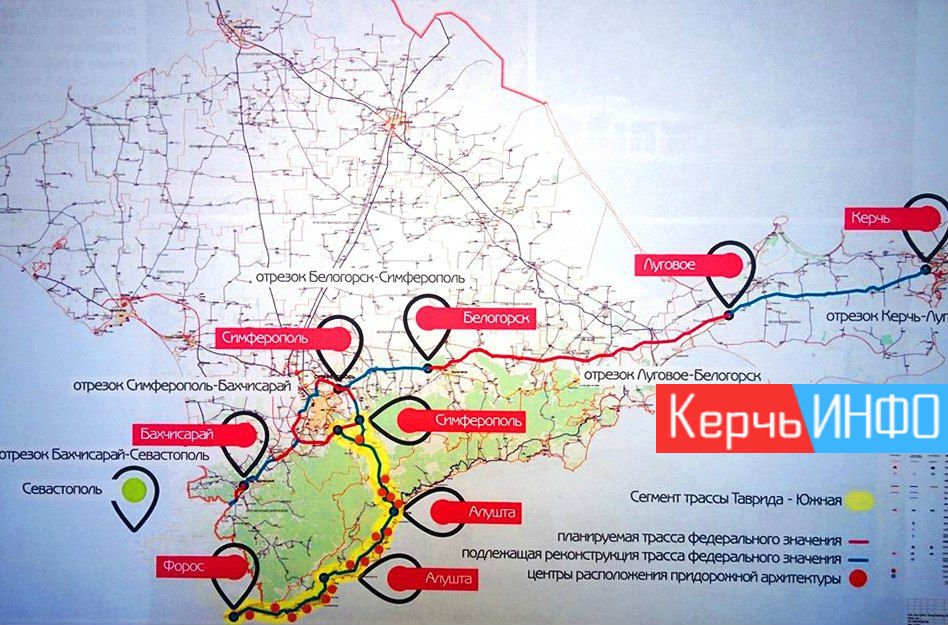
An important element of the Taurida road construction is a diversion route around Simferopol, the first 7.3 km section of which (Mirnoye – Dubki) was put into operation in 2010. In the meantime, the construction project for the second section – Dubki – Levadki (8.2 km) was prepared.
The Russians couldn’t event approve the almost completely prepared project for two and a half years of annexation, although Aksenov ordered to finish the construction of the second section by the end of 2015 in front of cameras. This year, the ‘head’ of Crimea became more cautious and promised to finish the construction before the end of 2017. Incidentally, the cost of the project increased from 6.8 billion to 9 billion rubles ($108 million), 2.5 billion ($40 million) of which should be used before the end of the year, in the speeches of the Crimean ‘Prime Minister’ during two weeks.
Who repairs Crimean roads?
The Russians take the leading positions among companies involved in repairs of Crimean roads – the companies from Rostov, Krasnodar, Moscow, St. Pete and even from Irkutsk spend budget funds on the occupied peninsula in spite of a minimal authorized fund (10,000 rubles – $160), the presence of several neighbors at registration and financial problems. The exception, perhaps, is just the CJSC “VAD” – a corporation that works on large budget projects. It is the company Aksenov appointed as the only contractor of the project to construct a road to the Kerch bridge and Taurida road.
The LLC “Krym Magistral Stroy” was an absolute leader in terms of contracts among small companies that came to repair Crimean roads. In spite of the Crimean registration, the company’s origin goes through the Rostov company to the Moscow LLC “Sinergiya”, which has been experiencing financial difficulties since 2014. The Crimean company received contracts valued at 1.12 billion rubles ($17,8 million) in 2015-2016 (although this figure may be even higher at year-end).
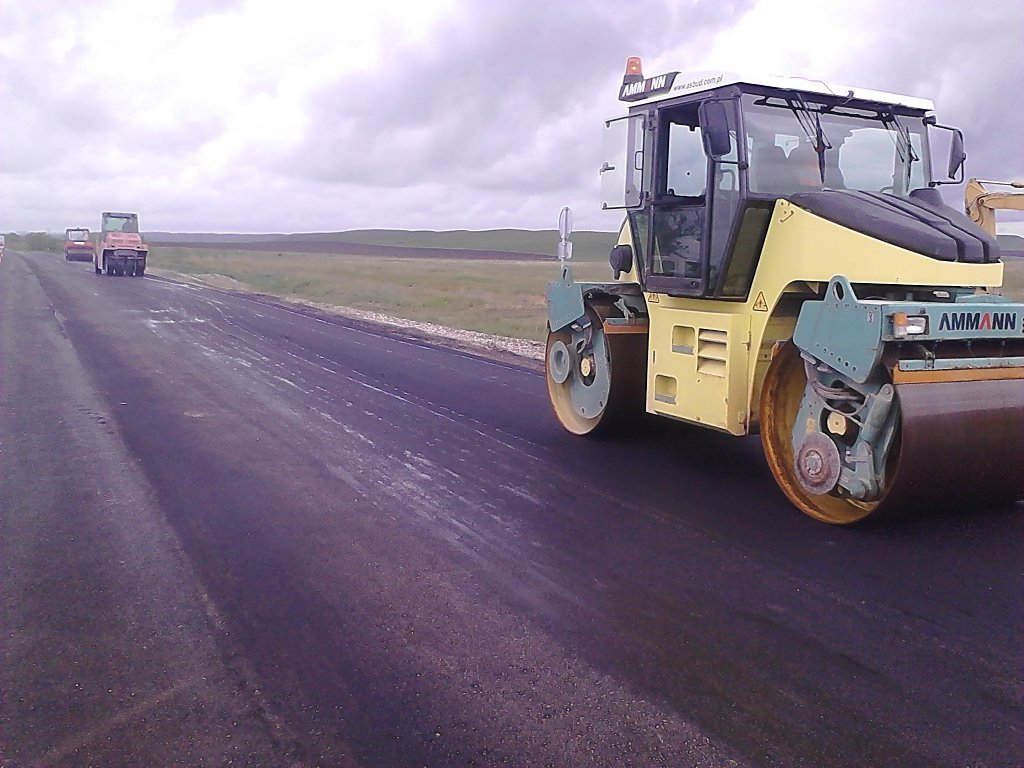
Repair works on the Kherson-Dzhankoy-Feodosia-Kerch road carried out by the LLC “Krym Magistral Stroy”
The company LLC “Dorinvest-Krym” was founded by the Russian businessmen Gagik Avakyan and Igor Kravchenko in 2014 and then it immediately received general contracts to repair the peninsula’s road network. The appointment of Kravchenko as a chief of the Automobile Roads Service of Crimea opened the door for the “Dorinvest” to the most attractive contracts amounting to nearly a billion rubles, without taking into account the repair of roads in the Crimean capital.
The company LLC “Kommuntrans”, which received contracts in the amount of 0.5 billion rubles and practically does not appear in the Russian databases, is also interesting. However, the close examination shows that this company has a Siamese twin with the same VATIN – the LLC “DTSK” headed by a well-known in Crimea Valentin Zavoychinsky, who previously held the post of a chief of the Roads Service and had close business contacts with ‘Donetsk’ businessmen. Probably, these contacts are still maintained as the company uses the equipment with Donetsk number signs in construction by breaking the Russian law. “Kommuntrans” also is a member of the Crimean FEZ.
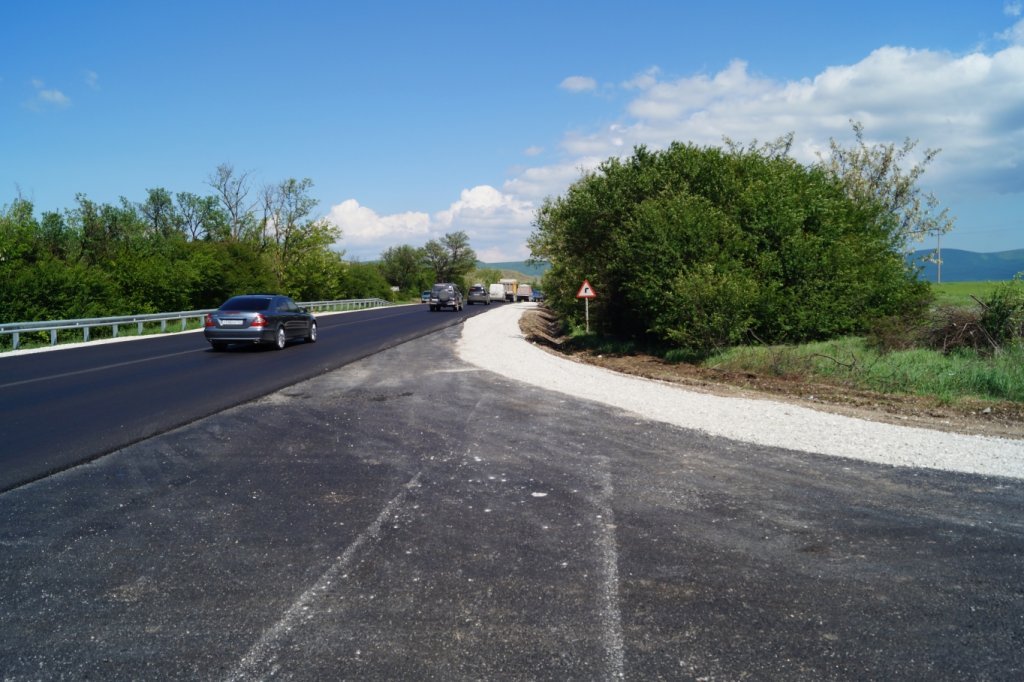
The Simferopol-Feodosia road section. Repair works are carried out by the LLC “Dorinvest”
Moscow companies LLC “Osnova” and CJSC “Tsentrdorstroy-826” as well as the LLC “Krymstroy” (founders from Krasnodar) and the LLC “Krymtekhtrans” (founders from Irkutsk) registered in Crimea also received the contracts in the amount of 200-300 million ($3-4 million).
Russian technologies on Crimean roads
Russian companies brought not only their own plants and equipment, but also the technologies, the usage of which led to the situation, when the asphalt laid became unusable during a couple of weeks, in Crimea.
For example, in the spring of 2016, the asphalt subsided and cracked after a couple of weeks after its laying as a result of repair works on the Feodosia-Simferopol road section between Rodniki and Radosnoye villages carried out by the Krymtekhtrans company. The reason is simple: the contractor laid a mixture of clay and stones instead of gravel chippings. As a result, the road surface subsided and cracked, and was immediately covered with the second layer. However, this didn’t help – cracks appeared again, but the Roads Service replied to the request of the social activist Aleksandr Talipov that they had no complaints about the quality and the materials met state standards.
The fate of the repair of the Simferopol-Krasnoperekopsk road section (on the way from the capital of Crimea to the airport) carried out by the company “Krym Magistral Stroy” for 695.7 million rubles ($11 million) is even sadder. It turned out after a couple of months of the work that the repair of poor quality was made, so they started to replace the contractors and the laid asphalt along with them as well as the 11 km of installed borders. However, the drivers say that a new repair will not have a long effect because of a lack of drainage, of course, if Russia hasn’t invented a water-repellent coating.
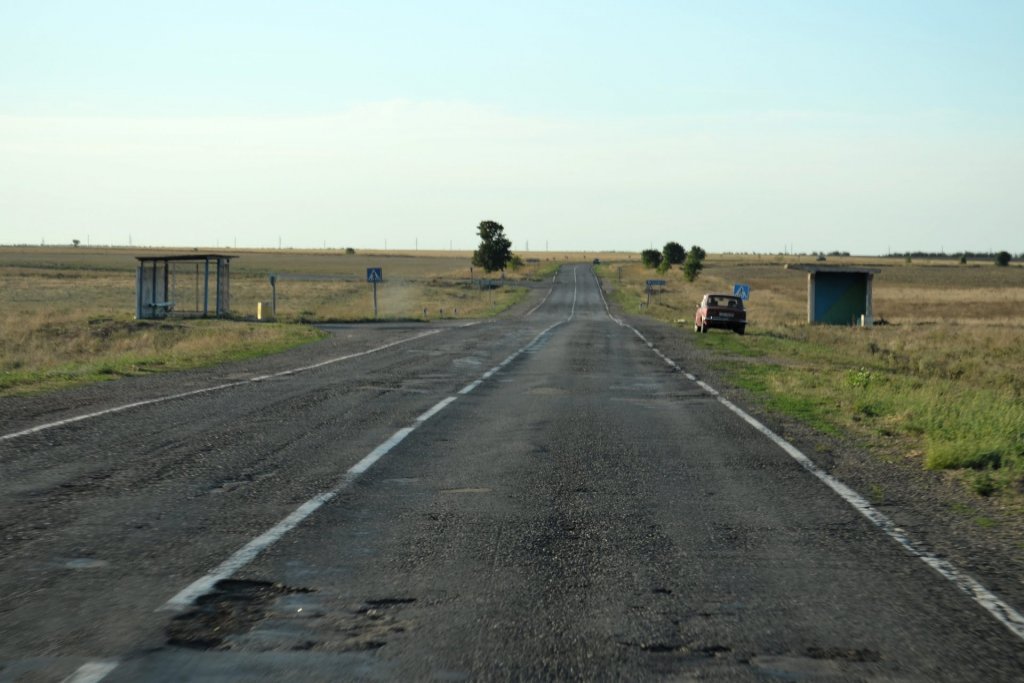
According to the ‘head’ of the SUE of the Republic of Crimea “Technical Supervision Service” Vladimir Aleksandrenko, the asphalt is simply “floated” in Dzhankoy. “They made a wrong structure and forgot that the volumetric weight of the asphalt is very small,” he commented on the situation.
However, a Crimean road builder with years of experience said that this explanation with the incompetence of the technical supervision.
“The asphalt density is 2-2.5 times higher than the water density, so there are no chances that it was ‘floated’. Most likely, in this case, the construction technology has been broken – the groundwork base was not cleaned of the dirt and dust, so the asphalt lacked cohesion and was washed away by rain,” a Crimean Roads Service employee explained us possible reasons for a failure occurred with the repaired road coating.
Unfortunately, Crimean roads will soon have all chances to “flow” into the Black Sea with such ‘experts’ as Aleksandrenko.
To sum up, the Russian authorities finally began to repair the roads of Crimea and launched a flood of activities over two years of inactivity – just before the elections in the State Duma. However, the quality of repairs carried causes serious complaints in most cases and the Crimeans look at the roads they have to ride in the future with horror considering the cynicism the Russian companies pack Russian billions into the asphalt in the best case and sometimes simply into the dirt with. In this context, no one care about Crimean roads as well the peninsula itself, which was only a means to launder the money from the Russian budget. But the peninsula’s roads are gradually transformed into impassable roads with all these manipulations.
Sergey Marchenko





